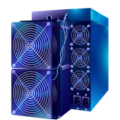Asic Miner Profitability
Our mining profitability calculator helps users quickly pinpoint the most lucrative mining options by delivering real-time data in multiple fiat and cryptocurrency currencies, including USD, EUR, GBP, AED, CAD, AUD, THB, ETH, and BTC. It allows precise electricity cost inputs up to three decimal places for highly accurate profit estimations. Users can access a clear overview of top-performing miners, algorithm-specific performance tables, and visually organized listings of mineable coins with recognizable cryptocurrency icons, simplifying decisions for maximum returns.
| Model | Hashrate |
Profitability
Profit
|
|---|---|---|
|
IceRiver AE3
2GH/s
|
2 GH/s |
$41.60/day
|
|
Iceriver AE2
720MH/s
|
720 MH/s |
$14.83/day
|
|
IceRiver AE3
600MH/s
|
600 MH/s |
$12.52/day
|
|
Goldshell AE Max II
540MH/s
|
540 MH/s |
$6.85/day
|
|
IceRiver AE1 Lite
300MH/s
|
300 MH/s |
$6.26/day
|
|
IceRiver AE1 Lite
250MH/s
|
250 MH/s |
$5.06/day
|
|
Goldshell AE Max
360MH/s
|
360 MH/s |
$2.33/day
|
|
Goldshell E-AE1M
230MH/s
|
230 MH/s |
$1.69/day
|
|
IceRiver AE0
60MH/s
|
60 MH/s |
$1.25/day
|
|
Goldshell AE Box 2
54MH/s
|
54 MH/s |
$0.28/day
|
|
Goldshell AE-BOX
37MH/s
|
37 MH/s |
$0.20/day
|
|
Goldshell AE-BOX Pro
44MH/s
|
44 MH/s |
$0.18/day
|
|
Goldshell Byte
5.5MH/s
|
5.5 MH/s |
$0.01/day
|
|
Goldshell AE Card
5.5MH/s
|
5.5 MH/s |
$0.01/day
|
Our cutting-edge mining calculator offers comprehensive insights across all major cryptocurrency algorithms, helping users easily identify the most profitable options for their specific hardware. The algorithm data is continuously refreshed to keep pace with the dynamic crypto mining industry, providing accurate evaluations based on real-time profitability statistics and overall market activity. This empowers users to make well-informed choices that reflect the latest mining conditions and algorithm performance.
Bitcoin Mining Difficulty
Monitor the latest Bitcoin network difficulty metrics in real time, including block times & estimated time until the next difficulty adjustment.
Progress
Current progress:
61.51 %
Remaining Block
Blocks Left:
776
Remaining Time
Time Left:
~ 5 days 1 hours
Next Change
Upcoming change:
6.9 %
Block Time
Current Block Time:
9.4 minutes
What is zkSNARK algorithm?
Why Should You Rely on Our Profit Calculator for Accurate Mining Insights?
A ledger can hold a secret that speaks through a proof, and the proof echoes the ledger. zkSNARKs are Zero-Knowledge Succinct Non-Interactive Arguments of Knowledge that let one party prove a claim without revealing the hidden data. They preserve privacy and reduce bandwidth, while keeping verification simple for nodes that check blocks. Proofs are short, and many verifiers run in near constant time relative to the statement size. In cryptocurrencies they enable fully encrypted transactions that still satisfy consensus rules and remain auditable at the protocol level. Zcash demonstrates this with shielded transfers that conceal sender, recipient, and amount while staying valid on chain. Mining in zkSNARK-oriented systems shifts effort from hash puzzles to the generation and checking of cryptographic proofs. Verification is lightweight for validators, but proof construction is compute heavy and memory sensitive. Provers run large multi-scalar multiplications, number theoretic transforms, and pairings on elliptic curves such as BLS12-381. High performance rigs favor GPUs for parallel MSM and NTT kernels, while FPGAs and ASICs improve energy efficiency on fixed elliptic curve pipelines. Engineers push throughput with pipelining, warp-level parallelism, vector instructions, and low-latency memory architectures. Custom firmware, tuned schedulers, and tight memory layouts reduce cache misses and kernel stalls during long proving jobs. Stable thermals, reliable power delivery, and error-correcting memory protect correctness under sustained load. Profitability depends on proof throughput per watt, local electricity costs, network difficulty, block issuance, fees, and downtime risk. Real-time calculators can estimate returns for a given rig by modeling proof rate, power draw, and difficulty trends. Future work aims to cut overhead in proof aggregation and recursive verification so blocks carry fewer bytes and verify faster. Systems adopt universal or updatable setups and multi-party ceremonies to limit the risk from trusted setup parameters. Compromise of those parameters could enable counterfeit proofs, so transparency and ceremony design matter. New proof systems such as Groth16, Plonk, and Halo2 streamline circuits and widen application scope, while KZG commitments keep proofs succinct. Alternative designs like zkSTARKs remove the trusted setup and improve resistance to quantum attacks, though proofs are often larger and verifier costs differ. As privacy coins and apps gain traction, builders seek architectures that balance compute, memory bandwidth, and communication so the outer network and the inner proof engine move in step.
Latest ASIC Miners
Check out the latest ASIC miners added to our site. These are the newest listings, featuring the most recent models.
V3
Nerdminer
AE3
IceRiver
Antminer L11 Hyd 2U
Bitmain
Why ASIC Mining?
The Advantages of ASIC Mining Compared to Other Mining Types
ASIC (Application-Specific Integrated Circuit) mining involves specialized hardware designed exclusively for mining cryptocurrencies like Bitcoin, offering unmatched efficiency and performance. Unlike general-purpose GPUs, ASICs are optimized for specific algorithms, delivering significantly higher hashrates while consuming less power per hash. This makes them far superior for mining tasks, as they maximize profitability by reducing electricity costs and increasing mining output. ASIC miners are purpose-built, providing stability and reliability in high-demand mining environments, unlike GPUs which are prone to overheating and wear during prolonged use. Their compact design also allows for easier scalability in large mining operations. By focusing solely on mining, ASICs eliminate the overhead of multi-purpose computing, resulting in faster block-solving times. This efficiency translates to higher rewards, making ASICs the preferred choice for serious miners aiming to stay competitive in the cryptocurrency market. In contrast, GPU mining, while versatile, cannot match the raw power and cost-effectiveness of ASICs for dedicated mining tasks.
Optimized for Mining
Energy Efficient
Reliable & Stable
Scalable
More about the zkSNARK algorithm
See how our profit calculator delivers accurate, real-time mining insights, helping miners make informed decisions.
zkSNARKs (Zero-Knowledge Succinct Non-Interactive Arguments of Knowledge) are cryptographic proofs that let a prover demonstrate a statement’s truth without revealing the underlying data, enabling on-chain validation with off-chain secrecy-an austere mechanism that hides the fearful complexity of private computation beneath a calm, verifiable surface; in blockchains like Aleo and Zcash, this permits fully encrypted, “shielded” transactions to be validated under consensus rules while concealing sender, recipient, and amount, shifting the work of “mining” from puzzle-solving to generating and verifying proofs with minimal on-chain footprint, typically small proofs and fast verification; under the hood, modern zkSNARKs rely on arithmetization (e.g., R1CS or PLONK-style circuits), polynomial commitments, fast Fourier transforms, and heavy elliptic-curve operations such as multi-scalar multiplications over pairing-friendly curves like BN254 or BLS12-381, making GPUs, FPGAs, and sometimes ASICs valuable for accelerating FFTs and MSMs, improving throughput and energy efficiency while battling memory bandwidth and latency bottlenecks with techniques like Pippenger’s method, batched MSM, and careful parallelization; although verification is lightweight, proof generation is intensive and historically requires a trusted setup to create a structured reference string-mitigated by multi-party ceremonies (e.g., Powers of Tau), updatable setups, and universal SRS schemes (Sonic, Marlin, PLONK), yet still a point of systemic caution because compromised parameters could poison the well; ongoing research targets recursion for scalable rollups and private smart contracts, SNARK-friendly hashes (Poseidon, Rescue) for circuit efficiency, and alternative transparent systems such as zkSTARKs, which remove trusted setup and lean on hash-based security with stronger post-quantum resilience at the cost of larger proofs; in practice, the strategic frontier is clear: squeeze latency from proof generation, compress memory flows, and preserve privacy at scale so that the network can know enough to trust-while knowing almost nothing at all.
 English
English
 German
German
 Hungarian
Hungarian
 Dutch
Dutch
 Spanish
Spanish
 French
French
 Italian
Italian
 Czech
Czech
 Polish
Polish
 Greek
Greek



















